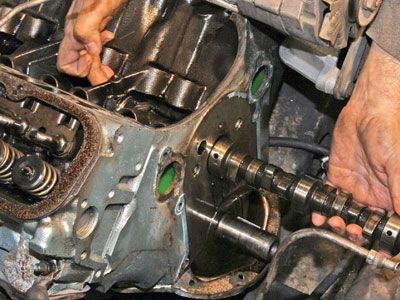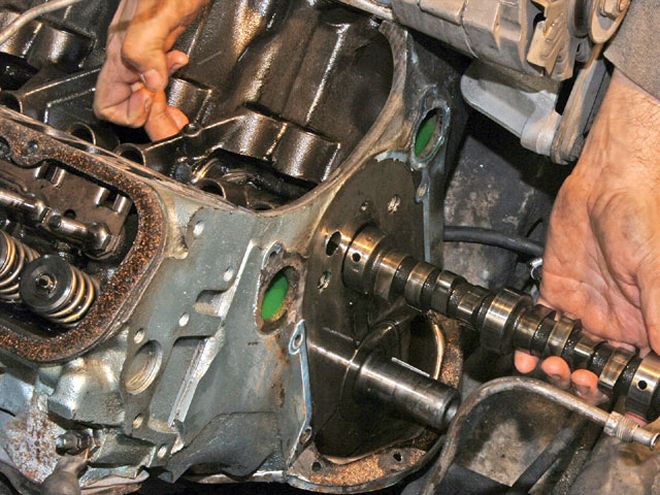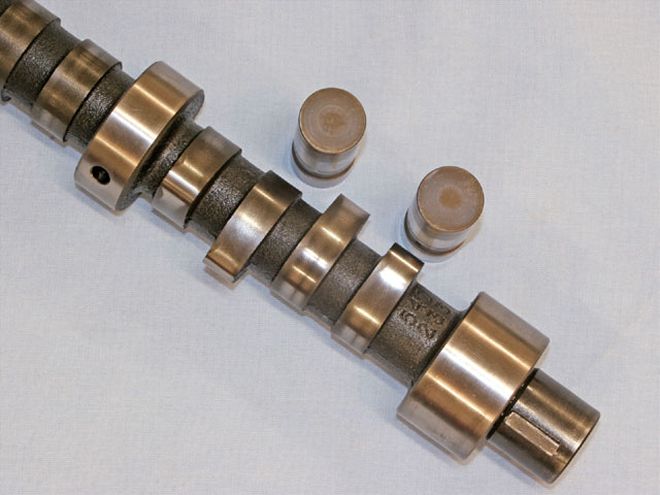

Like intake manifolds and carburetors, it seems that valvetrain components are commonly replaced for a myriad of reasons, and at its heart is the camshaft. While some hobbyists perform a cam swap hoping to increase their Pontiac's performance, others may be looking to improve street manners or simply replace a worn unit. Whatever the reason, camshaft replacement is certainly a time-consuming and tedious task that requires a specific break-in procedure.
With the recent oil reformulations, flat-tappet lobe failure has become a great concern for hobbyists and camshaft manufacturers alike. This situation is just one of the reasons surrounding the recent popularity of more-costly roller grinds, but since hydraulic flat-tappet units contain such great low-buck performance, they remain a popular choice for budget builds. If broken in and maintained properly, they should offer many miles of reliable performance. Follow along as we replace our Pontiac's flat-tappet camshaft with another in a weekend, and incorporate one professional engine builder's technique for successful break-in.
Camshaft Basics
The camshaft in a Pontiac engine is responsible for driving the mechanical fuel and oil pumps and ignition distributor, but its primary function is controlling valve action. A tappet (or lifter) following the shape of the lobe uses a pushrod to transfer its motion to a pivoting rocker arm ultimately lifting the valve off its seat at a specific crankshaft angle.
Types of camshafts available on today's market include hydraulic and mechanical (or solid) flat-tappet, and hydraulic and mechanical roller-the operational characteristics and attributes of each can be found in "Top 6 Cam Questions Answered" (HPP May '07). Other than the mechanical units in the early '60s Super Duties, all production Pontiac V-8 engines utilize hydraulic flat-tappet camshafts, which rely on pressurized engine oil to maintain minimal valve lash.
As we learned in "The Slippery Truth About Oil" (HPP June '06), oil manufacturers have reduced the amount of high-pressure anti-wear additives found in most passenger car oils that minimize metal-on-metal contact of the lobe and lifter. While one might assume this spells doom for every flat-tappet camshaft in service today, simply using heavy-duty or off-road type oils, and/or incorporating a separate oil additive with each oil change may be an easy solution. But the most critical point in any flat-tappet cam's life is initial break-in and, without proper technique, any is susceptible to failure despite oil quality.
Break-In Basics
The lobe and lifter face of any flat-tappet camshaft is hardened to a certain degree, and a specific break-in procedure produces a distinct polishing pattern on the contact surfaces of the two. This pattern should remain for at least the duration of the engine's life, but if abnormal wear passes through the hardened portion of the lobe and/or lifter, camshaft failure is inevitable.
No direct lubrication is provided to the contact surfaces of the lobe and lifter, but they are indirectly lubricated by oil seepage from the lifter bores and splash oiling from the crankshaft. During installation, both surfaces should be coated with a specific camshaft break-in lubricant. This lubricant is of higher viscosity lubricant. This lubricant is of higher viscosity and is designed to prevent the scuffing that would otherwise occur during cranking and before normal oil circulation begins at initial start-up.
As quickly as the engine fires, its speed should be mechanically increased towards 2,500 rpm and maintained for several minutes. The added rpm is necessary because it promotes high rates of pressurized oil circulation and splash lubrication. It also forces the lifters to rotate quicker on the lobes thereby enhancing the polishing effect, and is believed to lessen the overall inertial load on the camshaft.
Proper break-in should take 25 to 30 minutes to complete. During that time, the engine should never be run at idle speed. Oil pressure and coolant temperature must be closely monitored and the engine should be immediately shut down upon the first indications of problems. There's little harm in interrupting the break-in process to allow the engine to cool. Once the problem is fixed, the engine is restarted and the process can continue until the camshaft supplier's suggested run time has elapsed.
 The camshaft and lifters we removed were in excellent condition, and could certainly be used in a future project. Many builders recommend when installing a used cam and lifter set that each lifter be returned to its original lobe, or failure is possible. If original lifter order is unknown, new lifters are certainly an option. In either case, treat the installation as if using new components, and closely follow the supplier's suggested break-in, and you should have no troubles reusing a cam.
The camshaft and lifters we removed were in excellent condition, and could certainly be used in a future project. Many builders recommend when installing a used cam and lifter set that each lifter be returned to its original lobe, or failure is possible. If original lifter order is unknown, new lifters are certainly an option. In either case, treat the installation as if using new components, and closely follow the supplier's suggested break-in, and you should have no troubles reusing a cam.
Conclusion
Few will argue that some modern oils have contributed to a number of flat-tappet camshaft failures, but we have to wonder, too, if improper break-in was a factor. We're finding now that even experienced hobbyists who've followed the same break-in procedures for years without incident are slightly revising their practice to ensure proper lobe and lifter polishing, and are making a bottle of oil additive a requirement at normal oil change intervals.
While some may feel that a flat-tappet camshaft is antiquated, and that roller technology has taken its place, we cannot forget the large number of hobbyists who don't have the budget or a combination that might benefit from a roller set-up-especially the young enthusiasts whose first brush with a flat-tappet is in a vintage Pontiac. So if you're considering a flat-tappet cam swap, closely follow the supplier's suggestions for break-in and long-term use, and your low-buck investment will likely reward you with thousands of miles of issue-free performance.
Torque SpecsItemSpec (ft lbs.)Thrust plate 20Timing chain sprocket 40Timing chain cover bolts30Timing chain cover studs15Oil pan to timing chain cover12Harmonic balancer160Fuel pump 25Fan and pulley assembly to water pump hub30Valley pan3.5Valve covers8Distributor30Spark plugs25Coolant crossover to timing cover15Intake manifold40 (25 if aluminum)Carburetor4